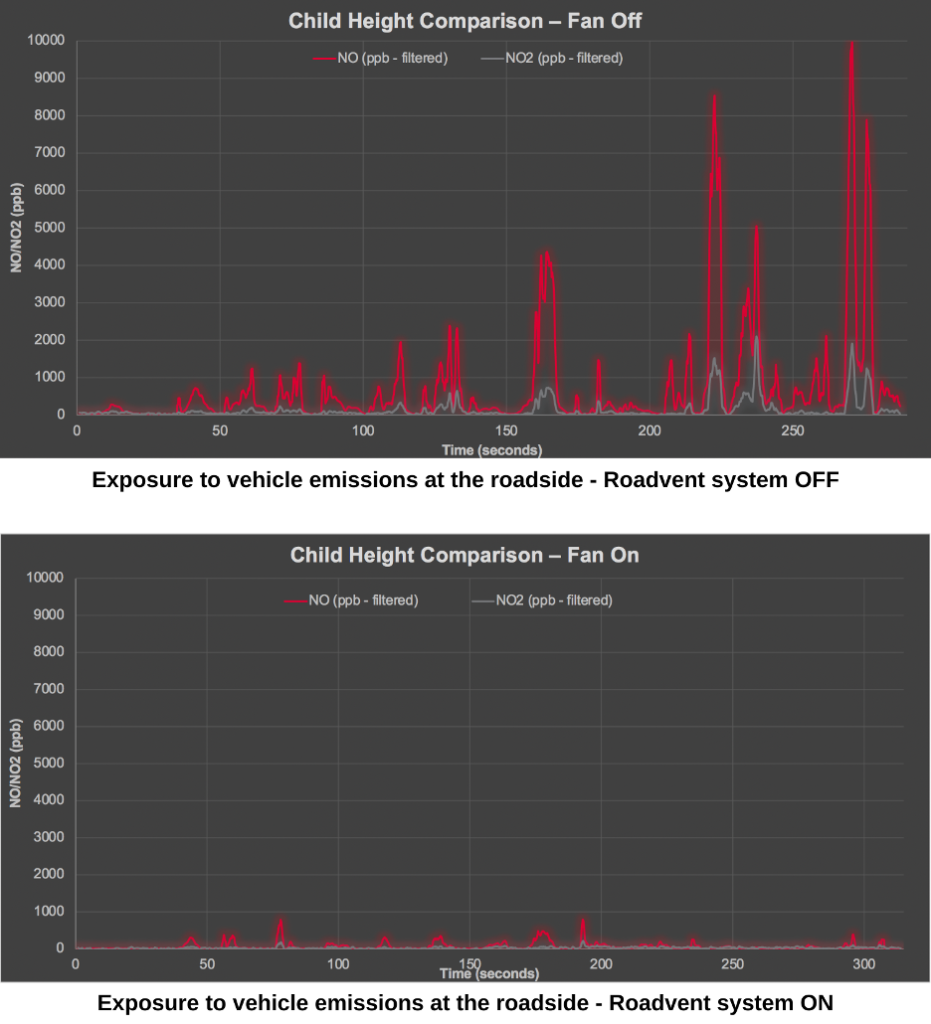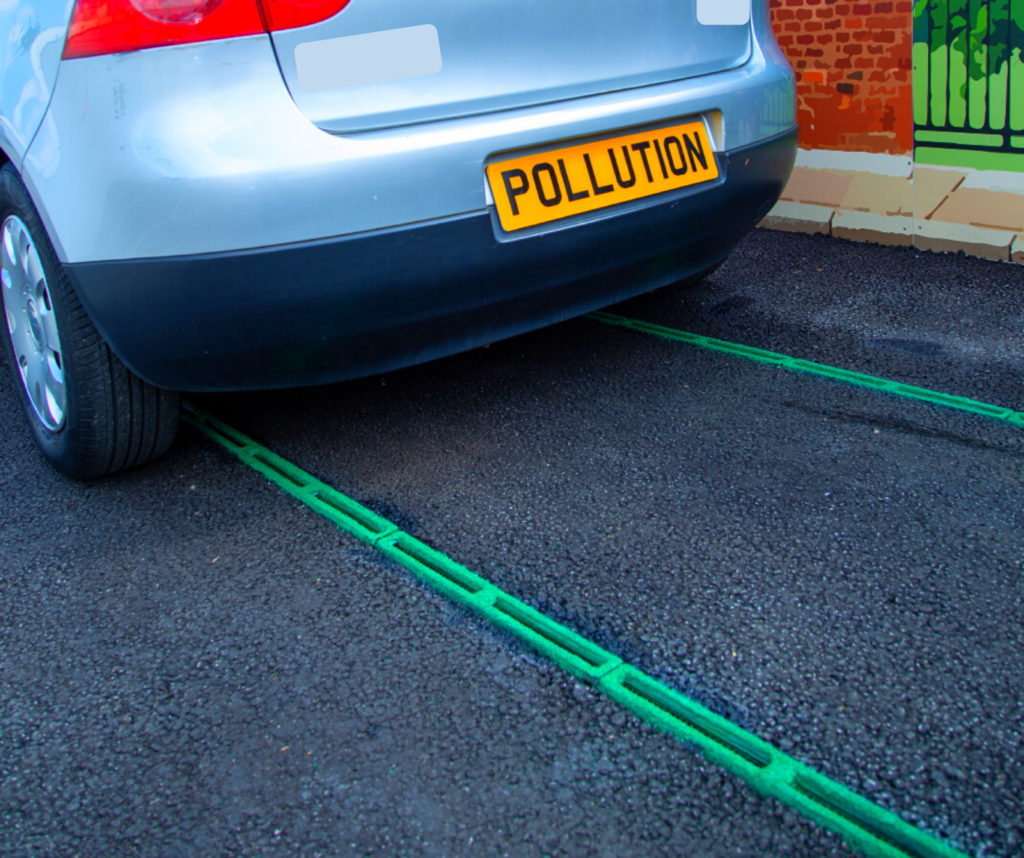A recent study by Dr Mark Peckham from emissions measurement specialist company Cambustion has validated the effectiveness of the Roadvent system at reducing roadside pollutant levels, a key metric used by local authorities in measuring air quality.
The UK Government has worked with local authorities to tackle illegal levels of NO2 pollution, but progress has been slower than expected, according to the National Audit Office (NAO). It also stated that existing measures will not be sufficient to achieve most of the national air quality targets by 2030. However, a recent study shows that new technology has been developed in the UK and is readily available to reduce roadside human exposure to air pollutants by 91%.
What more could local authorities be doing to improve air quality sooner?
Dr Mark Peckham’s study validated the efficacy of the Roadvent system in decreasing roadside pollutant levels, a critical metric employed by local authorities in measuring air quality.
The graphs below, taken from Cambustion’s report, show the difference in exposure to harmful vehicle emissions of NO and NO2 from a child’s height at the roadside with the system switched off versus when the system is switched on.

The Roadvent system is installed into the road as parallel lines of air intake slots, which suck in the dirty fumes from a small radius of influence around vehicles’ exhaust pipes, brakes and tyres. Once the air is drawn into the slots, it travels to the roadside air cabinet where harmful pollutants such as NO, NO2, VOCs, PM2.5 and PM10 undergo a series of filtration processes, releasing 99% clean air.
Deploying the system in appropriate locations
Paul Lewis, Professor Emeritus at Swansea University Medical School & Director of the Centre for Health and Environmental Management Research and Innovation (CHEMRI) in the School of Management, commented: ‘In terms of how the health impacts of NO2 and PM2.5 could be reduced, the Roadvent technology could play a significant role if local authorities quickly deployed it in appropriate locations.
‘For example, the evidence is well established on how air pollution impacts pedestrians and drivers when vehicles are idling in traffic, and Roadvent is designed to mitigate against this. Even a reduction of 1 ug/m3 on average could significantly impact the relative risk for respiratory and cardiovascular episodes while reducing the life years lost within the population and productivity at work due to days lost. As governments seek to revise their air quality objectives in readiness for new legislation, in partnership with local authorities, they need to focus on priority sites where technologies like Roadvent can help achieve target reductions for PM2.5 and NO2 while improving health and wellbeing.’
Illegal levels of air pollution have been identified across the UK. It often occurs in locations where the surrounding building structures and street layouts create an environment susceptible to the build-up of high concentrations of vehicle pollutants due to the restricted atmospheric dispersion, also known as the ‘street canyon effect’.
Alarming statistics
Recent studies highlight alarming statistics showing these pollution hot spots, including roads near nurseries, schools, bus stops, hospitals and care homes, which expose some of the most vulnerable to poor air quality.
Steve Manning, Senior Scientific Officer for Newport City Council, added: ‘We recognise that the presence of narrow streets with continuous buildings on either side creates street canyons which exacerbate the build-up of pollutants from vehicle emissions, and emissions management may be a short to medium term solution whilst more vehicles change from conventional fuels to electricity and hydrogen.
‘The Roadvent system appears to offer such an engineered solution. It could provide transitional mitigation, which would achieve compliance with the air quality objective for nitrogen dioxide in one of our air quality management areas until this can be sustained by a cleaner vehicle fleet and travel alternatives.’
The Government’s Transport Decarbonisation plan commits to phasing out the sale of all new non-zero emissions road vehicles by 2040. However, even after 18 years from now and after that, those vehicles will still be present on UK roads. Whilst targets are set to tackle the issue in the long term, the health of millions of people will continue to be at risk within the transition period.
Furthermore, according to the Environment Act 2021, the government has a legally binding duty to bring forward two national air quality targets, which are proposed to also be met by 2040: a maximum annual concentration of PM2.5 to be 10µg/m3 across England, as well as a 35% reduction in population exposure to PM2.5 compared to 2018.
Emissions from brake and tyre wear
Although the ban on the sale of all non-zero emissions vehicles and the PM2.5 targets share a deadline, the two are very distinct and potentially conflicting. Electric vehicles are currently classed as non-polluting, yet they still emit particulate matter (PM) from brake and tyre wear. This seems to be an oversight. What will happen when all vehicles are electrically powered, but non-exhaust emissions are still around?
In England, the total cost due to PM2.5 to the NHS and social care is estimated to be £1.5 billion by 2025, and £5.1 billion by 2035, according to a report released by Public Health England. Tackling fine particulate emissions is both a public health and an economic emergency.
In addition to targets that reduce levels of air pollution nationally in the long term, councils have a significant amount of responsibility to meet their own localised air quality targets now, which will also lead to overall compliance with national targets. Reducing airborne pollutant levels to below legal limits on the worst affected roads can be extremely challenging as local authorities balance out the cost-benefit of specific solutions.
Protecting our children
Recently, Labour Councillor Simon Curry (Medway Council) criticised the council’s current plans to tackle air pollution, saying he didn’t think the measures proposed would make a difference and that he struggles to see where the levels will fall. ‘The purpose of this is to reduce the pollution because currently, if it carries on, another generation of children in that area will grow up with compromised lungs,’ commented Cllr Simon Curry.
With legal levels of NO2 being breached in the UK since 2010, according to the NAO, it is clear that additional action is urgently needed to achieve targets. The rising cost of living slows down this process even more as families struggle to make ends meet, and more sustainable transport becomes yet more unattainable for many.
New technologies like Roadvent present a low-cost, turnkey solution to reducing localised air pollution levels instantly upon installation, making it a viable medium to help local authorities comply with their air quality targets as early as 2023, while hard and major shifts in the transportation and infrastructure sectors are developed over time.
Everyone has the inalienable right to breathe clean air
Barry Sheerman, MP for Huddersfield and Chairman of the Westminster Commission for Road Air Quality shared his views: ‘All people have an inalienable right to breathe clean air. Sadly, the reality is that millions of people across our urban areas are trapped living with the disastrous health implications of roadside air pollution. Therefore the contributions of companies such as Roadvent are invaluable. Like many others, I will be watching their technology closely and look forward to seeing it make an important contribution to creating healthier, greener and more prosperous communities.’
Pollution Solution’s Karina Freitas added: ‘We are providing local governments with an effective tool to offer communities clean air immediately. Roadvent is a solution that can instantly bring clean air to areas that currently exceed legal limits, such as schools, hospitals and highly polluted workplaces like serving hatches at drive-thru restaurants.
We believe clean air is a human right, yet substantial inequality exists surrounding access to good air quality. We are ready to assist local authorities in bringing clean air to those who need it most ahead of proposed targets.”
When asked about running costs, she said: “We are enabling councils to offset maintenance costs via the revenue generated from display advertisement on the roadside air cabinet’s digital screens.”
According to The Clean Air Strategy published by DEFRA in 2019, air pollution is the top environmental risk to human health in the UK. This strategy document contributes to the government’s action on clean growth (cleaning up the air will boost productivity and economic growth). It aims to make the UK a world leader in technologies, systems and services that tackle air pollution. However, local authorities’ ambition to reduce air pollution, their access to air quality grants, and the speed of adoption of new technologies play a big part in the progress made towards DEFRA’s goal.
Bringing forward the adherence to air quality targets by quick adoption of more ambitious measures in critical urban pollution hot spots could have a tremendous impact on the surrounding communities. From improving and extending lives, easing the NHS healthcare burden, saving wildlife, protecting ecosystems and helping the environment, the benefits of clean air are far too great to be postponed.
Further information on the Roadvent system mentioned in this article can be found here.




